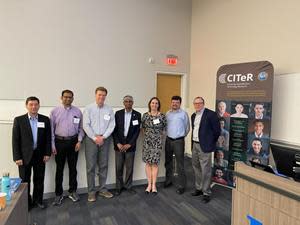Center for Identification Technology Research Celebrates 20th Year
CITeR-20

Potsdam, NY, June 30, 2022 (GLOBE NEWSWIRE) -- The Center for Identification Technology Research (CITeR), based at Clarkson University, is celebrating its 20th year.
CITeR, which performs research in the growing areas of identity science and biometric recognition, is a National Science Foundation Industry-University Cooperative Research Center. Biometrics is the automated recognition of individuals based on their biological and behavioral traits. Centers like CITeR focus on the needs of industry and government through collaborations between these groups and universities.
Stephanie Schuckers, Clarkson's Paynter-Krigman Endowed Professor in Engineering Science, serves as director of CITeR.
"At points, we wondered whether this research would become a 'solved' problem, and then new challenges would emerge: spoof detection, biometric cryptography, altered finger detection, biometrics at a distance, biometric permanence, and more," she says. "And now, here we are in 2022, with additional challenges such as face morphing, deepfakes, bias, template security, biometrics in children and many others."
Since awarding its first research grants in 2002, CITeR has performed cutting-edge research as new problems evolve each year.
Some fundamental scientific studies funded by CITeR examine permanence -- how a trait remains essentially unchanged throughout one's lifetime -- in aging adults and children. The research found that accurate identification by fingerprint in adults remained high over a 12- 15 -year period. CITeR researchers have also studied biometric recognition in children, which has applications in areas including immigration, refugee efforts and distribution of benefits. The findings show that identification by irises is stable for the three years they studied in children aged 4 to 11, and face recognition algorithms fail over a three-year period.
In the last three years, CITeR researchers have also developed several single and differential morph detectors to circumvent the problem of morph attacks. Face morphing is the process of combining two or more subjects in an image to create a new identity that contains features of both individuals. Morphed images can fool facial recognition systems into falsely accepting multiple people, leading to failures in national security and border control applications.
Single morph detectors are used during passport applications to authenticate if the submitted passport photo is a real or morphed image. Differential detectors are used to validate if the photo of the passport holder is the same as the photo in the passport.
Other current and past CITeR research highlights include cross-spectral face recognition; noncontact fingerprint recognition; template security and privacy; bias in face recognition; presentation attack detection (liveness detection); and soft and novel biometrics.
An anniversary celebration was held May 10-12 as part of CITeR's semiannual program review for industry and government affiliates and guests. The event was hosted at the Buffalo Museum of Science and University at Buffalo and included a keynote by University Distinguished Professor Anil K. Jain of Michigan State University and technical presentations on CITeR's ongoing research projects.
CITeR was founded in 2001 and held its first meeting in 2002. Lawrence Hornak at West Virginia University (WVU) was the founding director and was joined by Anil Jain from Michigan State University and Jim Wayman from San Jose State University. WVU faculty included Bojan Cukic, Michael Schuckers, Tim Norman and Stephanie Schuckers. In 2002, Bojan Cukic moved to the co-director role. Today, there are 40 active faculty members.
In 2011, Stephane Schuckers became CITeR director. Over time, CITeR also added the University of Arizona, University at Buffalo, Michigan State University and an international site, the Idiap Research Institute in Martigny, Switzerland.
The key to CITeR’s success is the participation of its affiliates. IUCRCs are unique in that their affiliates become directly involved in all phases of the center's research from planning to completion.
At the time of its 2002 founding, CITeR had five affiliates: the Department of Defense — Office/Biometrics Fusion Center, the Federal Bureau of Investigation, the National Security Agency, the Biometrics Foundation, and Viisage.
Today, CITeR boasts 22 members: ACV Auctions, Army Futures Command — Combat Capabilities Development, Command Armaments Center (CCDC — Armaments), Athena Sciences, Aware Inc., Cyber Street Solutions, Defence Research and Development Canada (DRDC), Defense Forensic Science Center (DFSC), Department of Defense — Defense Forensics and Biometrics Agency (DFBA), Department of Homeland Security — Office of Biometric Identity Management (OBIM), Department of Homeland Security — Science and Technology Directorate (S&T), the Federal Bureau of Investigation, IDEMIA, National Security Agency, Precise Biometrics, Public Safety Canada, Qualcomm Incorporated, SICPA, Synolo Biometrics Inc., TECH5, Veridium, and Xator Corporation.
Attachment
CONTACT: Melissa Lindell Clarkson University 315-268-6716 mlindell@clarkson.edu

